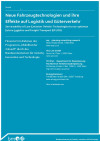EFLOG - Potential of the services of new vehicle technologies to impact on the offerings of logistics service providers
Short Description
Contents and goals
Based on various logistical operating functions, the R&D service first elaborated the preconditions for the transport of goods: How can parcel services, the supply of food retailers or industrial deliveries be presented? These goods deliveries face traffic on our road network in certain time windows on pre-planned routes. Such results should help to quantify the environmental benefits in terms of traffic and to constitute the transport-related logistical possibilities for realising reduction potentials.
Methods
From the methodical point of view a mutual feedback between experts under the aspect of need-focused technology diffusion directed towards the actual practice of freight transport was essential.
Activities are structured in three phases:
- First phase: a status quo analysis was performed to evaluate the vehicle drives currently marketed or being developed by those performance parameters that are relevant to assess their utility for certain logistic tasks and transport chains based on typical routes within the transport networks in order to map their internal, (network-)external and, ultimately, external impact on the environment. This analysis included all drive technologies that can be used for freight transport. Although the focus of the study will be on the patterns made by utility vehicles in road traffic, other modes of transport will not be ignored.
- Second phase: the next stage included a feasibility analysis in order to identify the framework conditions of efficiency and competitiveness offered by the vehicle models and the demand for them in the transport market under consideration of capacity aspects and the used traffic infrastructure. In the case of fulfilment of these conditions a certain grade of substitution fortraditional drive technologies Was assigned.
- Third phase: involved an anticipation analysis which addedthe temporal dimension of innovation diffusion to the discussion. It also highlighted the conditions of a conversion strategy, differentiated by type of operation (thus interweaving the logistic task with the territories to be supplied and their characteristic traffic infrastructure).
In addition exemplary, but realistic, data input was used to determine the input load requirements for the commercial vehicles used for the respective logistics task, in order to be simulated as trip cycles with the AVL programme Cruise in terms of fuel and energy consumption as well as CO2-equivalent emissions. Such results should help to quantify the environmental benefits to traffic and to constitute the logistical possibilities for realising reduction potentials.
On the basis of the trip cycle simulations of three sample transport runs with commercial vehicles of classes N1, N2 and N3, the aforementioned effects were calculated for 32 conventional, state-of-the-art diesel and natural gas (CNG) engines, for hybrids available on the market today or in the medium term, and for purely electrical drive configurations.
These results were placed in relation to the fuel consumption and emissions values with the transport cost (measured against the
vehicle weight) and with the transport service (measured against the conveyed payload), in order for them to flow into a sustainability-based concept of transport logistics performance indicators.
Results and Conclusions
In this way, the study highlights the competing interests of ecological expectations and effects raised considering sustainable handling of freight transport and the need to ensure an economically efficient and competitive use of transport systems. Thus, it is a basis for future guideline that outlines the direction of a road map for decision-makers in politics and business.
Notable reduction potentials were identified. They are between 19% and 39% just by installing a start-stop function in micro-hybrid vehicles. With full hybridisation, which allows a combination of conventional and electrical driving during the trip, up to 78% can be achieved, with the recuperation of electrical energy also making a contribution in urban traffic. In terms of potential savings, especially with regard to zero emissions, an electric commercial vehicle is unbeatable with regard to unrestricted use concerning range and performance, but still suffers at the moment from limited marketability. This is because the purchase costs of low-emission vehicles remain too high and cannot be realistically absorbed. Moreover, the present low price of oil should be used as a kind of "dividend" to drive forwards the transformation to the sustainable Mobility of Goods.
Publications
EFLOG - Potential of the services of new vehicle technologies to impact on the offerings of logistics service providers

The purpose of the study was to link the performance obtained from respective drive technologies, which are in various stages of their technological development up to ready-to-use models, of utility vehicles to the services offered by logistics providers and freight carriers to their customers.
Dipl.-Ing. Dr. rer. nat. Heinz Dörr, Kevin Hillen, MSc Viktoria Marsch, Bakk.techn. Dipl.-Ing. (FH) Andreas Romstorfer, MA Yvonne Toifl, BSc , et al.
Publisher: BMVIT
German, 252 Seiten
Publication Downloads
Project Partners
Project management
DI Dr. Heinz Dörr, arp – planning.consulting.research
Project partners
AVL List GmbH, TU Wien – Department für Raumplanung, Fachbereich Verkehrssystemplanung, Energycomment
Contact Address
arp – planning.consulting.research
Dipl.-Ing. Dr.rer.nat. Heinz Dörr
Tel.: +43 (1) 319 67 82
E-Mail: heinz.doerr@arp.co.at
